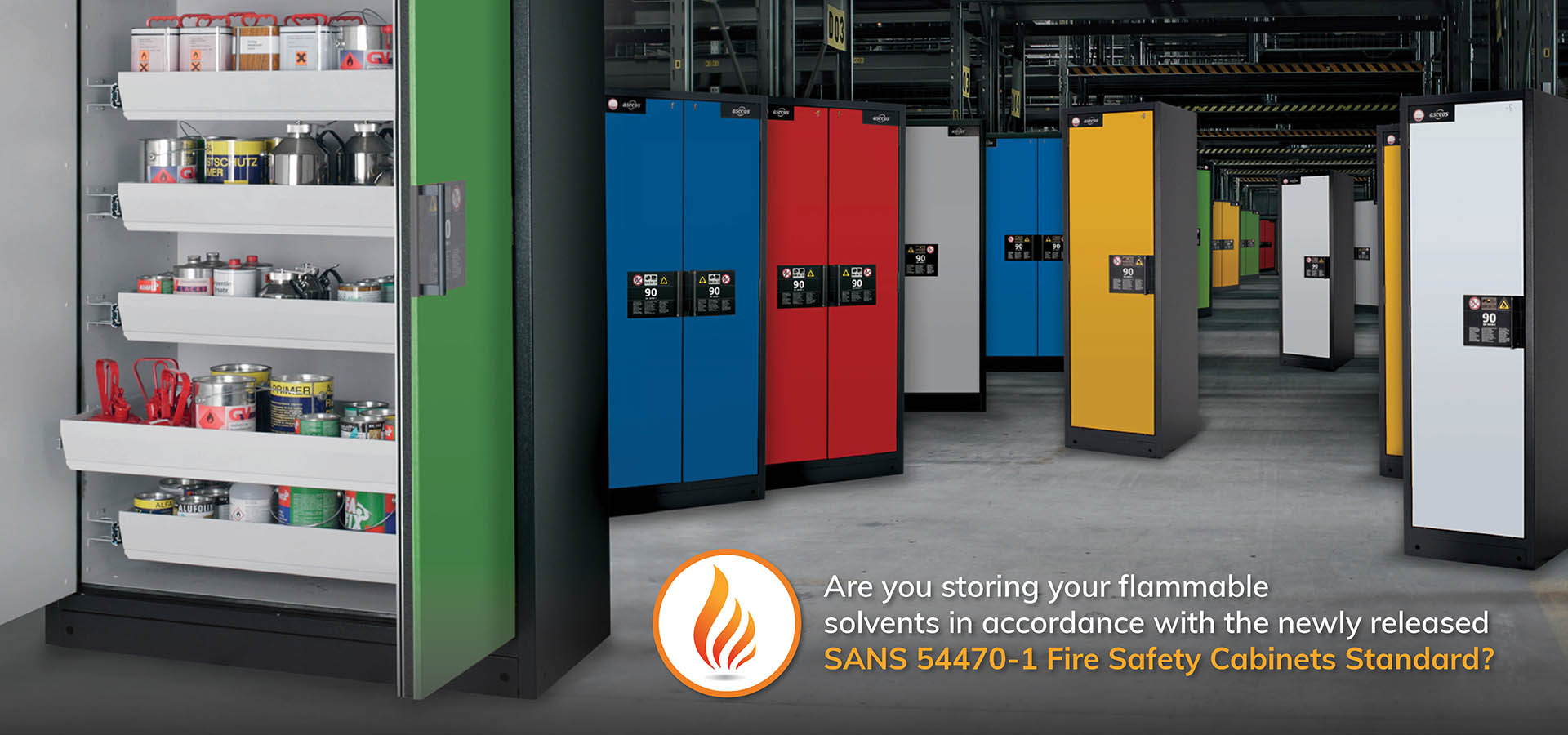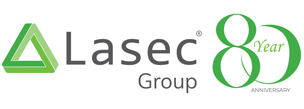BROWSE BY DEPARTMENT
- Biotechnology
- Clinical
- Consumables
- Furniture
-
Instruments
- Back
- Sample Collection
SANS 54470-1 Fire Safety Cabinets: A Practical Guide for Industrial Sites in South Africa

Keeping flammable liquids in a general metal cupboard isn’t just risky; it could put people, production, and compliance at risk. SANS 54470-1:2017 specifies the performance and construction requirements for fire safety cabinets used to store flammable liquids in workplaces across South Africa. The standard closely aligns with EN 14470-1, making Type 90 cabinets the benchmark for industrial safety and compliance. According to the asecos® range distributed by LASEC, Type 90 cabinets are engineered to maintain an internal temperature below critical thresholds for at least 90 minutes under direct fire, providing vital time for evacuation and fire response.
Why SANS 54470-1 matters on the shop floor (not just the lab)
Industrial environments, manufacturing, utilities, workshops, and warehouses face frequent ignition sources (forklifts, static, power tools) and variable ventilation. Storing flammables in compliant cabinets helps limit explosive atmospheres, compartmentalise hazards, and reduce heat transfer during a fire. Ventilation systems specifically designed for safety cabinets further reduce explosion risk by continuously capturing solvent vapours from storage zones. Where ducting exists, you can route vapours to an extraction unit (with exhaust-air monitoring), and where ducting is impractical, underbench or recirculating filtration options are available.
Cabinet options that fit industrial workflows
LASEC supplies a broad asecos® line-up to suit tall storage, underbench footprints, and mixed-hazard segregation needs:
- Tall Type 90 cabinets (S-Line, Q-Line): Supplied as standard with a bottom collecting sump and shelves, a practical combination for spill control and orderly segregation of containers.
Teams can also align cabinets with area colour coding: Q-Line doors are offered in seven colours for visual hazard management and 5S integration. - Underbench Type 90 cabinets (UB-Line): Ideal where space and workflow proximity matter, e.g., near mixing stations or test benches. These units maintain spill control with bottom-collecting sumps while fitting standard bench heights.
- Combi-cabinets (K-Line) for mixed hazards: Store flammables and corrosives in one footprint without breaking segregation rules by using physically separated compartments. The flammables side is built to 90-minute fire resistance in accordance with EN 14470-1, while the corrosives side is purpose-built for acids/alkalis.
- Acid & alkali cabinets (SL-Line) for corrosives only: These are not suitable for flammable liquids, which helps prevent common industrial storage errors when team members “park” solvents wherever space is free.
What “Type 90” performance means for risk reduction
In an industrial fire, time is everything. Type 90 certification indicates a minimum 90-minute barrier before the inside of the cabinet reaches dangerous temperatures. That buffer can be the difference between a localised incident and a plant-wide catastrophe, especially when combined with spill sumps (capture leaks before they vaporise) and engineered ventilation (continuously remove vapours).
Key takeaways
Comply with SANS 54470-1 to reduce risk and align with EN 14470-1 best practice.
Choose Type 90 for 90-minute fire protection and safer evacuation windows.
Match the cabinet to the hazard (flammables vs acids/alkalis) to avoid dangerous cross-storage.
Use ventilation/extraction to reduce explosive atmospheres and improve worker protection.
Type 90 vs. non-compliant storage (industrial reality check)
| Feature | Type 90 (SANS/EN-aligned) cabinet | Non-compliant cupboard |
|---|---|---|
| Fire resistance | 90 minutes until internal temps reach dangerous levels (Type 90) | Typically, no rated fire resistance |
| Spill control | Integrated bottom collecting sump to capture leaks | Often, no sump leaks spread, vapours form |
| Ventilation | Extraction/filtration options; exhaust-air monitoring available | Ad-hoc vents; vapours may accumulate |
| Segregation | Combi layouts separate flammables from acids/alkalis safely | Mixed storage likely; segregation breaches |
| Industrial fit | Tall and underbench formats for line-side access and 5S colour coding | One-size-fits-none; poor workflow alignment |
Next steps for EHS managers and plant leads
- Download the asecos® Safety Storage Cabinets brochure (PDF) to compare models and configurations.
- Browse LASEC’s Chemical & Hazardous Material Storage Range to specify the right solution for your facility.
Frequently Asked Questions (FAQs)
1) What is a Type 90 safety cabinet?
A Type 90 cabinet is tested to keep internal temperatures below dangerous thresholds for at least 90 minutes during a fire, supporting safe egress and response.
2) Can I store acids and flammables together?
Yes, use a combi-cabinet that physically separates compartments for corrosives and flammables to maintain segregation; the flammables side meets 90-minute resistance per EN 14470-1.
3) Do I need to ventilate my cabinet?
Ventilation reduces explosive atmospheres by removing vapours from storage; options include ducted extraction with exhaust-air monitoring or recirculating systems where ducting isn’t feasible.
4) Are acid/alkali cabinets suitable for solvents?
No. Acid/alkali cabinets are not suitable for flammable liquids; use a Type 90 fire safety cabinet for solvents and fuels.
5) What formats exist for tight spaces?
Underbench Type 90 cabinets (UB-Line) provide compliant storage beneath benches while retaining spill control via a bottom collecting sump.
What Cold Storage is Best for Your Biological Samples?
September 4, 2019
Introducing the Bio-Rad C1000 Touch Thermal Cycler
October 6, 2021
Self-Sampling Swab from Copan
September 4, 2019
Comprehensive Guide to Quality Control in Food & Beverage Industry
September 4, 2019
Topics
Tags
Events
Promotions
Memmert Cooled Incubator
Covid19
TB
Tuberculosis Testing
RAL Diagnostics
Treatment
Diagnosis
Mycobacterium Tuberculosis
Africa
Quick TB Test
TB Prep Kit
Fluo-RAL Methylene Blue Kit
RAL Stainer
DNA
RNA
Protein Purification
Kits
96-well plate
easy-to-follow procedure
Quick preparation time
Webinar
COVID-19 Testing Solutions
Sampling
RNA Extraction
RT Reaction
qPCR
Analysis and Validation
Sample Collection Kits
Purification Kits
Real-Time PCR
Covid Antibody and Antigen Rapid Tests
cell
greiner
gbo
cellstar
cell culture plates
cell culture flasks
cell culture dishes
mass cell culture
cellmaster
cell culture roller bottles
cell disc
tissue culture
vaccine production
genetic engineering
viral diagnostics
cancer research
3d cell structure
3d cell model
cell culture company
collagen type 2
cell culture techniques
Magnetic 3D Cell Culture technology
surface
quality control testing
Food
pathogen
pathogen
pathogen
listeria
packaging
QC
chemistry
sugar
titration
microbiology
shelf life
water-saving
wastewater
check weighers
beverage
food and beverage
food and beverage industry
quality control
chemistry
microbiology
water testing
Environmental Testing
Lt Sensors
ADInstruments
CFX Opus Real-Time PCR Systems
PCR Systems
quantitative PCR
Bio-Rad
Elpress Hygiene
Staff Hygiene Control
Chemical Dispenser
Ergonomic
microbiology lab equipment
Microbiology Laboratory Consumables
Microbiology Lab Supplies
Microbiology Lab Equipment
Glassware used in the Microbiology Laboratory
Incubation temperature for bacteria
Proven Benefits of Using a Peltier Cooled Incubator
Lasec
Lasec Labs
Lasec Laboratory News
Laboratory News
Laboratory Suppliers
Lasec Laboratory Suppliers
soil moisture meter
soil moisture sensor
Delta-T Devices
Bio-Rad C1000 Touch Thermal Cycler
Sustainability












Comments